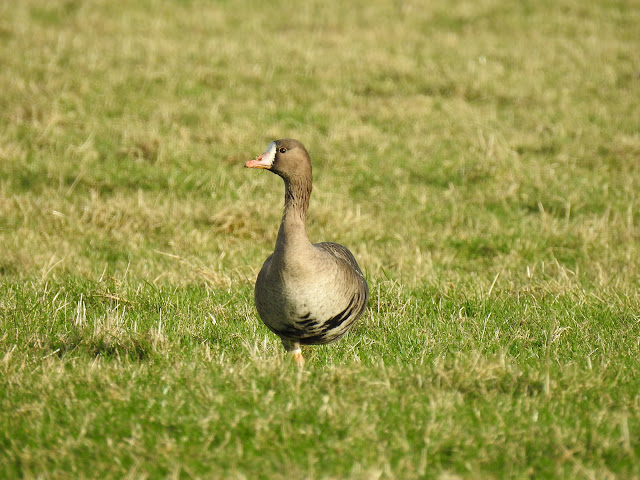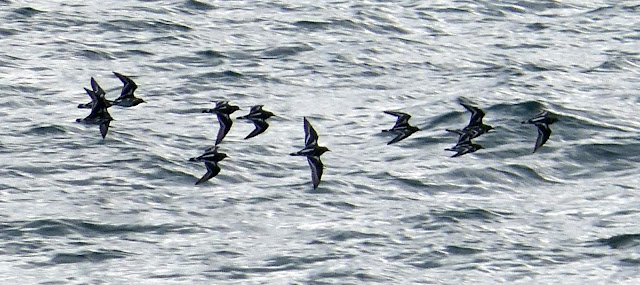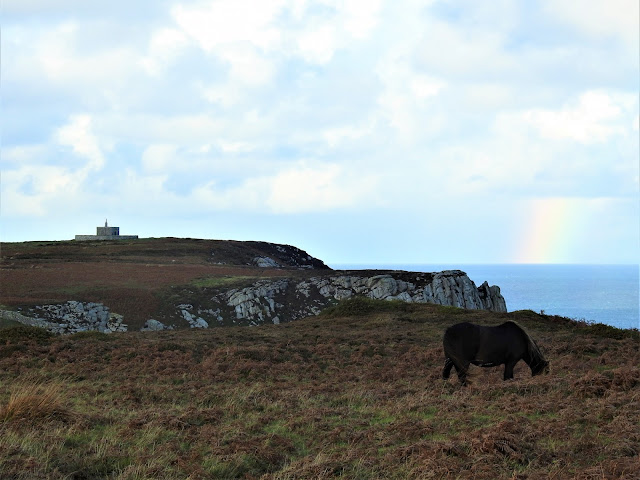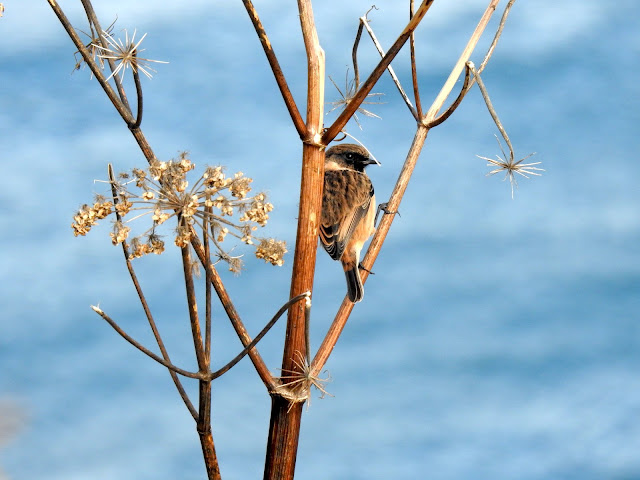27th December
A wet start but strong south-westerlies left a dry and bright afternoon.
Nothing new appeared to have arrived but the four Golden Plover were seen again on Ackland’s Moor and the White-fronted Goose and Pink-footed Goose were still in Brick Field. A Merlin was on the East Side and the Cormorant was still on Rocket Pole Pond.
The strong south-westerlies continued with heavy rain midday.
A Pintail was recorded on Pondsbury. This could be the same bird that was seen on Rocket Pole Scrape (= Kistvaen Pond) on 20th Dec. This is only the 5th record for Lundy. Also on Pondsbury were six Teal and the Cormorant that has been seen at Rocket Pole for the last few days.
Out at sea, 800 Kittiwakes, 80 Gannets, 40 Guillemots and 20 Razorbills flew past during a seawatch from the Ugly. A Great Northern Diver was seen in the Landing Bay in the morning and a small pod of around four Common Dolphins were off Quarry Beach.
29th December
Low cloud in the morning meant that no helicopter ran today. The cloud cleared up in the afternoon.
Due to the weather there were few birds recorded today. The highlights were two Goldcrests in Milcombe, the long-staying Whitefront and Pinkfoot, and eight Teal on Pondsbury.
30th December
Very low cloud and strong westerlies all day!
A very quiet day due to the strong winds and rain. Very few passerines were recorded with no Robin or Dunnock seen or heard all day. A walk round Millcombe only revealed a Wren and eight Redwings. The low cloud had forced down some large flocks of gulls, with 55 Herring Gulls in Lower Lighthouse Field and 40 more in Brick Field along with the two long-staying geese. A single Lesser Black-backed Gull and six Great Black-backed Gulls were seen in with the Herring Gulls.
Surprisingly, given the big waves, at least two Common Dolphins were seen off Benjamin’s Chair – they were only spotted due to the presence of 15 diving Gannets.
31st December
Low cloud all day but the helicopter finally managed to reach the island.
The final day of 2021 and the only apparent new arrivals were the new guests and four Wigeon on Pondsbury. The Great Northern Diver was seen again in the Landing Bay, and the two geese were in Brick Field. Millcombe was busier than yesterday with nine Chaffinches, four Redwings and a Goldcrest, as well as the more usual species.
2021 highlights
The year started off well with a Snow Bunting and Black Redstart seen in January. A Coal Tit and Firecrest were in Millcombe until March. Migration started off with the first Sand Martin on 26 Feb. It was an excellent year for Lapland Bunting with a maximum of five together in February. A Woodlark was seen on 27 Feb. Large flocks of seabirds were along the East Side throughout winter with some scarcer species such as Red-throated Diver, Little Gull, Mediterranean Gull and Common Gull.
A Pink-footed Goose stayed on the island from 6–18 Mar. Numbers of Blackcap and Chiffchaff were increased to double figures by the end of March. March also saw the arrival of the first Swallows, House Martins, Willow Warblers, Grasshopper Warbler and Wheatears. A single Tree Pipit was recorded at the end of the month. In Jenny’s Cove there were three Puffins on 6 Mar. Also in March there were two records of Long-Tailed Tit: two together in Quarter Wall Copse and a single in Millcombe that stayed until the end of the month.
Birds arriving in April included the first of the waders, among them a Bar-tailed Godwit, Sanderling, Ringed Plover, Whimbrel, Dunlin and Common Sandpiper. Also arriving in April were the first Cuckoo, Swift, Spotted and Pied Flycatchers, Common Redstart, Whinchat, Yellow Wagtail, Sedge Warbler, Reed Warbler, Garden Warbler, Lesser Whitethroat and Whitethroat. The last Fieldfares were recorded in April, with one Redwing seen on 2 May. Rarities recorded in April included two Hoopoes on the Terrace and a Corn Bunting in St John’s Valley.
Things were getting busier by May with rarities including two Golden Orioles and a Subalpine Warbler in Millcombe, an Osprey over Quarry Beach and a Common Rosefinch first seen in Millcombe and then ringed at the Lodge. June was an excellent month to be on Lundy, with a Rustic Bunting on the 1st and the bird of the year, a first for Britain, a Sulphur-bellied Warbler on the 8th. Other rarities in June were a Subalpine Warbler, Rose-coloured Starling and an Ortolan Bunting.
The long-term studies of breeding seabirds continued with the majority still increasing in population since the removal of rats. Puffins, Guillemots, Razorbills and Manx Shearwaters all increased, while numbers of breeding Kittiwakes remained stable. Surveys undertaken of potential Storm Petrel nesting areas revealed at least 50 pairs.
July was a quiet month with the majority of birds being local breeders. A Turtle Dove was seen in Quarter Wall Copse at the beginning of the month. A few scarcities started migrating through towards the end of July, including a Green Sandpiper, Hobby, Little Grebe and a Marsh Harrier.
On 7 Aug two Balearic Shearwaters flew past Rat Island with Manx Shearwaters. The Marsh Harrier was seen again from 9th to 12th and a Wryneck was ringed in Millcombe on the 29th. There was another good passage of waders in August, with a Wood Sandpiper seen flying over Rat Island on 9th and another on the 15th. Also recorded were Black-tailed Godwit, Knot, Green Sandpiper, Turnstone, Redshank and Greenshank.
September was getting quieter for common migrants but with a few rarities recorded. Another Common Rosefinch was ringed, this time in Millcombe, staying for a few weeks. A Wryneck was recorded by the Terrace Heligoland Trap and an Ortolan Bunting was seen in Barton Field. Island scarcities in September included a Great Spotted Woodpecker, Great Tit, Wood Warbler, Pale-bellied Brent Goose and a ringtail Hen Harrier.
The first winter migrants started to arrive in October with Woodcock, Fieldfare, Redwing, Yellow-browed Warbler, Brambling, Lapland Bunting and Snow Bunting all recorded. There was also a massive influx of Siskins with 1,170 recorded on the 20th. A long list of rarities included a Twite, Red-backed Shrike, Red-eyed Vireo, Dartford Warbler, Great White Egret, Little Bunting, Red-breasted Flycatcher, Chough and Glossy Ibis.
A few rarities were recorded in December included a Red-breasted Flycatcher, Barred Warbler and Whooper Swan. A putative Buff-bellied Pipit was recorded in Barton Field early in the month. Island scarcities before the year's end were a Corn Bunting, Purple Sandpiper, Yellow-legged Gull, Pink-footed Goose, White-fronted Goose and a Pintail.

































